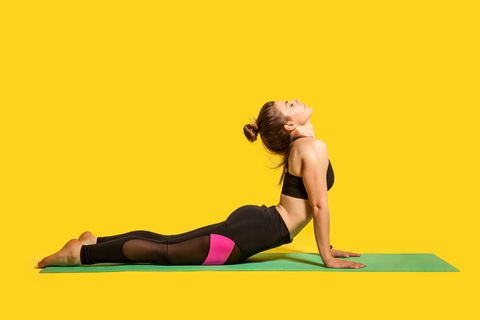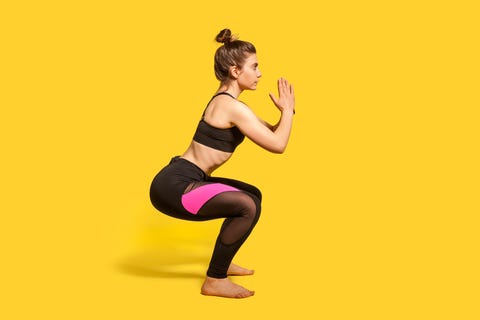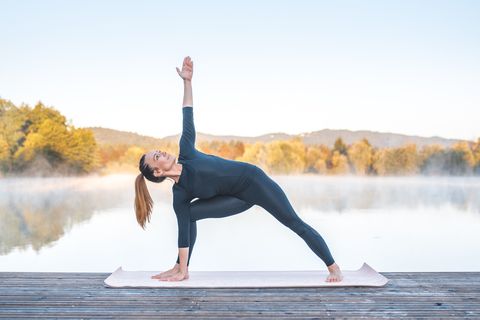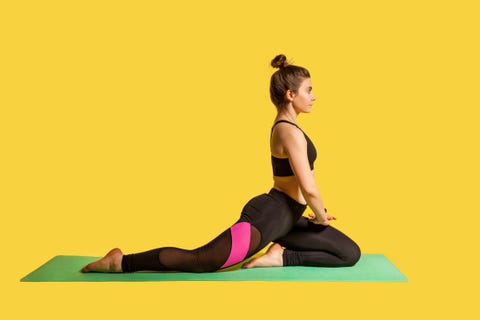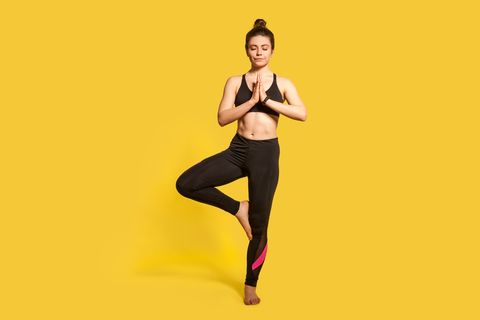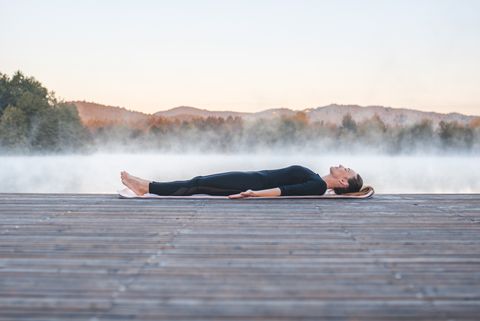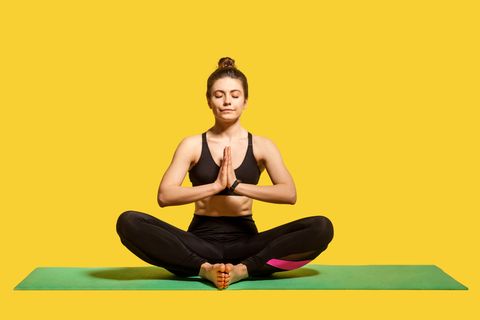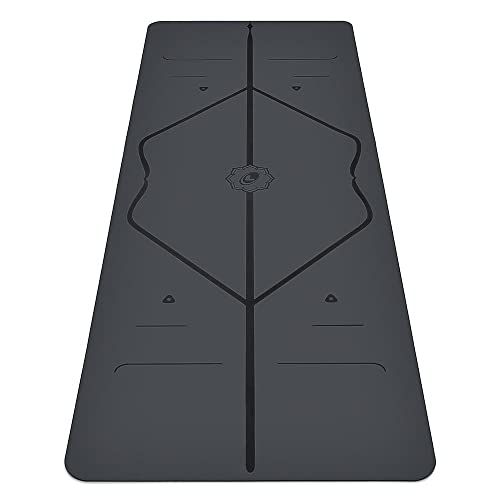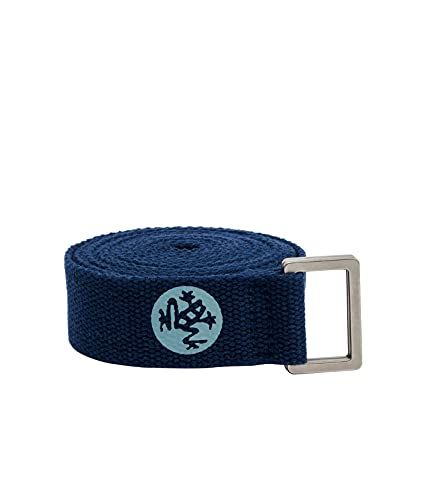It’s never a bad time to start practicing — and reaping the benefits of! — yoga. This ancient practice offers options for all fitness levels and has become increasingly popular in the U.S., with about one in seven Americans practicing yoga, according to a 2017 national survey. While the complex inversions and more rigorous styles can be intimidating, there are many different types of yoga that can be approachable for anyone, at any age or physical ability.
“Start with a class designed for beginners,” says Peloton Yoga and Meditation Director Ross Rayburn. He recommends beginners kick things off by practicing just once a week and building a more regular cadence from there.
Whether you plan to join a yoga studio or you want to take a virtual yoga class from home, we’ve compiled everything beginners need to know about starting a regular yoga practice. Of course, before beginning any new exercise regimen, our health and fitness experts recommend consulting with your healthcare provider.
What is yoga?
Yoga is a spiritual and physical practice rooted in Indian philosophy that has existed for thousands of years, according to the National Institutes of Health National Center for Complementary and Integrative Health. There are several different styles of yoga that range from gentle, meditative experiences to more physically intense formats. The mind-body exercise typically consists of doing sequences of physical poses combined with deep breathing techniques.
“Defining ‘yoga’ is a bit like trying to define a grand concept like spirituality or culture,” Rayburn says. “I’ve always been drawn to a dynamic definition that resonates differently depending on the person, time and place. Any practice, both internal and external, that weaves intention, knowledge and affirmative agency can be yoga.”
Yoga Health Benefits
From improving strength and flexibility to helping manage stress, the benefits of regularly practicing yoga are vast, but the specific benefits you experience will differ based on the type of yoga you do, according to Rayburn. “Alignment-based yoga can help with strength, flexibility and functionality, while meditational or devotional types of yoga can yield myriad benefits relating to mental and emotional health,” he says.
Some generally well-established yoga health benefits include:
- Improved flexibility and balance: A 2016 study in the International Journal of Yoga found improvements in flexibility and balance among a group of male college athletes that practiced yoga twice a week, for a total of 10 weeks. A systematic review from 2019 supports those findings, confirming significant improvements in yogis’ lower body flexibility.
- Increased strength and muscle tone: One study that evaluated adults participating in a 12-week Hatha yoga intervention saw significant improvements in both cardiorespiratory endurance and muscular strength. Another study in sedentary adults found that a Hatha yoga regimen was as good as a stretching-strengthening exercise program in improving strength, flexibility, mobility and more.
- Enhanced body awareness: Yoga has been long known to improve body awareness, primarily through its ability to connect breath and movement through the practice. A pilot study in 2022 found that a 12-week yoga course for individuals with multiple sclerosis significantly improved their body awareness.
- Stress relief: You may feel the stress relief benefits of yoga after just one session. Older adults who practiced yoga regularly for eight weeks reported feeling less stressed — something a salivary cortisol test supported in a 2016 study. What’s more, a 2017 study found that middle-aged women secreted lower amounts of cortisol (the stress hormone) after 90 minutes of yoga, compared to resting.
- Weight management: A 2013 study analysis concluded that regular yoga practice can help promote weight loss and maintenance, combined with a healthy diet. Another study from 2018 published in the International Journal of Behavioral Nutrition and Physical Activity found that a regular yoga practice supported healthy eating, management of emotional eating and even increased capacity to be active.
- Injury prevention: Since yoga can improve flexibility and mobility, it can be a great tool for fixing muscle imbalances and alleviating tightness than can contribute to future injuries.
- Help with pain management: Scientists named yoga one of the most effective exercises for alleviating chronic pain in a 2017 study review. In a 2020 review of 25 randomized controlled trials, researchers found that 20 studies supported positive outcomes regarding yoga and back pain relief.
- Manage chronic disease symptoms: Regular physical activity in general can help prevent several chronic diseases. When it comes to yoga, thousands of study participants in a year-long relaxation program involving meditation, yoga and prayer visited their doctors 43% less than the year before, according to 2015 research from Massachusetts General Hospital. Another set of studies out of UCLA found just 12 minutes of Kirtan Kriya meditation (which involves chanting and finger poses) every day for eight weeks helped decrease the immune system’s inflammatory response, which is promising since inflammation levels are tied to pretty much every major disease.
10 Best Yoga Poses for Beginners
When it comes to the best poses for beginners looking to start a yoga practice, Rayburn suggests starting with any of these common poses — try flowing through the sequence below to create a complete yoga workout at home.
Pro tip: Take your time and hold each movement for a few breaths before moving on to the next one.
1. Child’s Pose (Balasana)
This foundational pose can be relaxing and serve as a great reset during a class. If you ever need a second during your flow to regroup, you can always come back to child’s pose.
How to:
- Start kneeling on the floor and bring your big toes together. Sit on your heels and separate your knees out wide.
- Exhale as you fold forward and rest your torso down between your thighs.
- Rest your arms along your thighs or alternatively reach your hands out towards the front of your mat for an Extended Child’s pose.
2. Downward Facing Dog (Adho Mukha Svanasana)
Downward facing dog may be one of the first poses you’ll learn in any yoga class, since it is an important part of many yoga practices. It’s one of the main poses during sun salutations and something you can return to throughout class, as well.
How to:
- Begin on your hands and knees with wrists under shoulders and knees in line with hips.
- Spread your palms and fingers into the mat as you root down through your hands.
- Curl your toes under and exhale as you gently lift your knees off the floor.
- Focus on lengthening your tailbone and lifting your pelvis towards the ceiling. Gently straighten your knees as able to without locking out completely. Pull your shoulders back towards your hips.
3. Low Lunge (Anjaneyasana)
Another favorite pose of Rayburn’s, this one is great for stretching the lower body and opening up the chest.
How to:
- Begin in downward facing dog. Exhale as you step your right foot forward in between your hands with the right knee over the right heel.
- Lower your left knee to the mat and slide that left leg back until you feel a gentle stretch through the front of the left thigh.
- Inhale as you sweep your arms out to the sides and lift your torso up, reaching your fingers towards the ceiling and drawing the tailbone down to the floor. Be sure to repeat on the opposite side.
4. Cobra Pose (Bhujangasana)
This pose, also common in sun salutations, is ideal for improving posture as backbends are great for counteracting prolonged sitting.
How to:
- Begin by lying face down flat on the mat with your palms flat on the mat near your shoulders.
- Inhale as you lift your head and chest off the floor, rolling your shoulders back and down. Keep your elbows slightly bent and close to your sides.
5. Chair Pose (Utkatasana)
This powerful pose is great for strengthening the legs, arms and core.
How to:
- Stand tall and inhale as you raise your arms straight overhead. Your biceps should be slightly in front of your ears and palms should face inward.
- Bend your knees as you exhale, aiming for thighs to be parallel to the floor.
- Hold the pose for 30 seconds up to a minute.
6. Extended Side Angle Pose (Utthita Parsvakonasana)
This empowering pose increases balance and strength. If you can’t reach your fingertips all the way to the ground, consider utilizing a yoga block.
How to:
- Begin standing tall with feet about four feet apart. Turn the left foot out 90º and angle the right foot in slightly. Place arms in a “T” position with palms facing down.
- Bend your left knee so that your left thigh becomes parallel with the floor. Hinge at the hips to bring your left arm towards the floor and place your left fingertips on the ground or on a block.
- Extend the right arm up over the right ear with your palm facing down and turn your chest towards that raised arm. Hold the pose for 30 seconds to a minute, then perform on the opposite side.
7. Pigeon Pose (Eka Pada Rajakapotasana)
Great for opening the hips, this popular yoga pose targets the lower body and can provide a fantastic stretch. Ease into the movement and only fold forward if you feel stable once in position.
How to:
- Begin on your hands and knees. Gently slide your right knee forward to just outside your right hand. Angle your right shin towards the front of the mat.
- Square the hips towards the front of the mat. You can add a folded blanket under your right side for support.
- Stay upright and breath into the pose, or bring your torso down to the ground as you bend forward over the right leg. Repeat on the opposite side.
8. Bridge Pose (Setu Bandha Sarvangasana)
Another popular backbend, this pose can help improve posture and also relieve lower back pain.
How to:
- Begin lying on your back on the mat. Bend your knees and keep your feet hip width apart. Inch your feet a bit closer to your glutes. Arms should be flat along your sides on the mat.
- Press through your feet as you raise your hips, focusing on lifting from the pelvis. You can progress the pose by clasping your hands under your back on the floor.
9. Tree Pose (Vrksasana)
Not only does this standing yoga pose help improve your balance and coordination, but it also focuses on posture and alignment. Engage your core to help steady yourself.
How to:
- Begin standing tall with toes and feet pressed into the floor. Place your hands on your hips and find a steady gaze in front of you.
- Slowly raise your left foot onto your right shin or thigh while maintaining your gaze forward. Press the foot into the leg and breathe. Once you feel steady, consider bringing your hands to your heart or stretching them out overhead like branches.
- Hold for a few breaths, then step your foot back down and repeat on the other side.
10. Corpse Pose (Savasana)
This grounding pose is all about relaxation and quieting the mind. If you feel any tension under your lower back, consider placing a rolled-up blanket beneath your knees.
How to:
- Lay flat on your back on the mat. You can support your head and neck with a folded blanket if needed.
- Keep your shoulders down and away from your ears and breathe into the pose.
Types of Yoga Classes
Whether you’re looking for a rigorous workout or a more meditative experience, there are a variety of yoga styles to meet your needs. Yoga was often referred to as a tree in ancient times, with six branches that include Raja (path of meditative focus), Karma (path of service), Bhakti (path of devotion), Jnana (path of wisdom and knowledge), Tantra (path of rituals) and Hatha (path that focuses on mastery of the body). You may gravitate towards one particular branch, but know that you can explore different paths and may find that many of these branches naturally overlap.
In terms of the types of yoga classes offered, some common ones you may encounter include:
- Ashtanga yoga: An athletic and dynamic style that involves linking a series of poses together with breath.
- Bikram yoga: A specific set of poses performed over a 90-minute class, typically in a heated room.
- Hatha yoga: A form of yoga that pairs poses with breathing exercises, encompassing Ashtanga, Vinyasa and more.
- Iyengar yoga: A style that focuses on alignment, sequencing and timing, with poses held for longer periods of time.
- Kripula yoga: A gentle practice that focuses on meditation, breath work and spirituality.
- Kundalini yoga: Repetitive poses paired with breath, chanting and meditation to activate energy at the base of the spine.
- Power yoga: A rigorous fitness-based practice consisting of high-impact yoga poses.
- Yin yoga: A slow-paced style that utilizes longer-held poses to target deep tissues in the body.
- Restorative yoga: A meditative form of yoga that uses props to help achieve total relaxation.
- Vinyasa yoga: An active, energetic flow of poses linked together with a synchronized breath.
Beginner Yoga Tips
If you’re brand new to yoga, Rayburn says that taking a class specifically designed for beginners is ideal so you can learn proper form at the very beginning of your yoga journey. In general, you’ll want to take your time with the movements and go slow, as the practice is designed to be mindful and purposeful in movement.
If your first class doesn’t go as well as you wanted it to, don’t get discouraged. “Don’t fall into the trap of thinking that ‘yoga is not for me’ just because your first class is not the best experience,” he says, adding that it may take a few classes to find an instructor that resonates with you and inspires you to practice regularly. Once you find the right class format and instructor, you’ll start to feel more empowered by the yoga experience.
While you may be tempted to go hard in the beginning, it is crucial to listen to your body and know your limits. “Notice if you’re not able to breathe deeply,” suggests Rayburn. “The breath can be a great guide for slowing down, modifying or taking a rest.” Also try to differentiate between feeling discomfort versus feeling acute sensations and pain. You can always return back to downward facing dog or child’s pose whenever you need to reset during class.
Yoga Gear for Beginners
Most yoga studios provide equipment, but check in advance to see if you’ll need to bring anything to class. You may want to take your own mat for hygiene purposes, or if you have a particular preference on style and thickness. Some yoga studios will provide accessories for you, but if you’re practicing yoga at home through a yoga app or online class, then you’ll want to consider having a few things on hand:
- Yoga mat: The right yoga mat can make a tremendous difference in your yoga practice. You’ll want to consider a few factors like firmness, thickness, size and materials. If you’re looking to purchase a new yoga mat, our scientists and wellness experts in the Good Housekeeping Institute have tested dozens to find the best yoga mat for every practice.
- Yoga blocks: Props like yoga bolsters or blocks can provide support and assist you in maintaining proper alignment during certain poses. You can place them in low, medium or high positions to accommodate for the level of support that you need.
- Yoga strap: Straps can be an incredibly versatile yoga accessory to provide support through different poses and also assist with stretching and flexibility.
When it comes to clothing, Rayburn says it depends on what makes you feel most comfortable. He generally recommends wearing yoga pants that allow you to move freely. Yoga is typically done barefoot, but if you prefer to wear socks, our experts suggest grip socks.
Why trust Good Housekeeping?
Stefani Sassos, M.S., R.D.N., C.D.N., NASM-CPT, has been working in the fitness industry for the past 10 years. As a NASM-certified personal trainer, she uses her knowledge of exercise science to create informed fitness content for Good Housekeeping. Stefani fell in love with yoga when she was pregnant with her first child and continues to incorporate it into her exercise regimen.
Nutrition Lab Deputy Director
Stefani (she/her) is a registered dietitian, a NASM-certified personal trainer and the deputy director of the Good Housekeeping Institute Nutrition Lab, where she handles all nutrition-related content, testing and evaluation. She holds a bachelor’s degree in nutritional sciences from Pennsylvania State University and a master’s degree in clinical nutrition from NYU. She is also Good Housekeeping’s on-staff fitness and exercise expert. Stefani is dedicated to providing readers with evidence-based content to encourage informed food choices and healthy living. She is an avid CrossFitter and a passionate home cook who loves spending time with her big fit Greek family.
This content is imported from OpenWeb. You may be able to find the same content in another format, or you may be able to find more information, at their web site.




